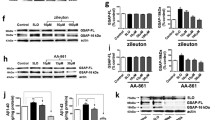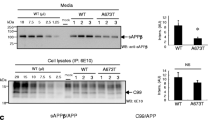Abstract
Background
Aberrant metabolism of the Alzheimer amyloid precursor protein (APP) or its amyloidogenic Aβ fragment is thought to be centrally involved in Alzheimer’s disease. Nonamyloidogenic processing of APP involves its cleavage within the Aβ domain by a protease, termed α-secretase, and release of the large extracellular domain, termed APPS. Secretion of APPS can be stimulated by phorbol esters, activators of protein kinase C, with concurrent inhibition of Aβ production. While the role of protein kinases on APP metabolism has been investigated, considerably less effort has been devoted to elucidating the role played by protein phosphatases. Okadaic acid, a protein phosphatase inhibitor, has been shown to stimulate secretion of APPS, but the identity of the phosphatase involved has not been investigated.
Materials and Methods
The secretion of APPS from COS-1 cells was measured in the absence or presence of various doses of serme/threonine-specific phosphatase inhibitors. Quantitation of the derived IC50 values was used to determine the identity of the phosphatase involved in the control of APP secretion.
Results
The availability of protein phosphatase inhibitors with different relative potencies against the different types of serine/threonine-specific protein phosphatase allowed us to examine which of the four known types of protein phosphatase might be involved in the regulation of APP secretion. Both okadaic acid and calyculin A stimulated the secretion of APP from COS-1 cells in a dose-dependent manner. The half-maximal dose for stimulation of APP secretion was approximately 100-fold higher with okadaic acid than with calyculin A.
Conclusions
The nearly 100-fold difference in the observed IC50 values for okadaic acid and calyculin A implicates a type 1 protein phosphatase in the control of APPS production. Protein phosphatase 1 (PP1) is known to be highly expressed in adult mammalian brain, both in neurons and glia. The identification of a specific phosphatase type in the control of APP secretion opens new avenues to the development of rational therapeutic intervention strategies aimed at the prevention and/or treatment of Alzheimer’s Disease.




Similar content being viewed by others

References
Glenner GG, Wong CW. (1984) Alzheimer’s disease: Initial report of the purification and characterization of a novel cerebrovascular amyloid protein. Biochem. Biophys. Res. Commun. 120: 885–890.
Caporaso GL, Gandy SE, Buxbaum JD, Ramabhadran TV, Greengard P. (1992) Protein phosphorylation regulates secretion of Alzheimer β/A4 amyloid precursor protein. Proc. Natl. Acad. Sci. U.S.A. 89: 3055–3059.
Gillespie SL, Golde TE, Younkin SG. (1992) Secretory processing of the Alzheimer amyloid β/A4 protein precursor is increased by protein phosphorylation. Biochem. Biophys. Res. Commun. 187: 1285–1290.
da Cruz e Silva OAB, Iverfeldt K, Oltersdorf T, et al. (1993) Regulated cleavage of Alzheimer β-amyloid precursor protein in the absence of the cytoplasmic tail. Neuroscience 57: 873–877.
Hung AY, Selkoe DJ. (1994) Selective ectodomain phosphorylation and regulated cleavage of β-amyloid precursor protein. E.M.B.O. J. 13: 534–542.
Gandy SE, Czernik AJ, Greengard P. (1988) Phosphorylation of Alzheimer disease amyloid precursor protein peptide by protein kinase C and Ca2+/calmodulin-dependent protein kinase II. Proc. Natl. Acad. Sci. U.S.A. 85: 6218–6221.
Suzuki T, Nairn AC, Gandy SE, Greengard P. (1992) Phosphorylation of Alzheimer amyloid precursor protein by protein kinase C. Neuroscience 48: 755–761.
Shenolikar S, Nairn AC. (1991) Protein phosphatases: Recent progress. Adv. Sec. Mess. Phosphoprot. Res. 23: 1–123.
da Cruz e Silva OB, da Cruz e Silva EF, Cohen PTW. (1988) Identification of a novel protein phosphatase catalytic subunit by cDNA cloning. F.E.B.S. Lett. 242: 106–110.
Ishihara H, Martin BL, Brautigan DL, et al. (1989) Calyculin A and okadaic acid: Inhibitors of protein phosphatase activity. Biochem. Biophys. Res. Commun. 159: 871–877.
da Cruz e Silva OB, da Cruz e Silva EF, Greengard P. (1994) Role of protein phosphatase 1 in the metabolism of Alzheimer amyloid precursor protein. Soc. Neurosci. Abs. 20: 440.
Weidemann A, Konig G, Bunke D, et al. (1989) Identification, biogenesis and localization of precursors of Alzheimer’s disease A4 amyloid protein. Cell 57: 115–126.
Smith PK, Krohn RI, Hermanson GT, et al. (1985) Measurement of protein using bicinchoninic acid. Anal. Biochem. 150: 76–85.
Laemmli UK. (1970) Cleavage of structural proteins during the assembly of the head of bacteriophage T4. Nature 227: 680–685.
Buxbaum JD, Gandy SE, Cicchetti P, et al. (1990) Processing of Alzheimer β/A4 amyloid precursor protein: Modulation by agents that regulate protein phosphorylation. Proc. Natl. Acad. Sci. U.S.A. 87: 6003–6006.
Wasco W, Bupp K, Magendantz M, Gusella JF, Tanzi RE, Solomon F. (1992) Identification of a mouse brain cDNA that encodes a protein related to the Alzheimer disease-associated amyloid beta protein precursor. Proc. Natl. Acad. Sci. U.S.A. 89: 10758–10762.
Wasco W, Gurubhagavatula S, Paradis MD, et al. (1993) Isolation and characterization of APLP2 encoding a homologue of the Alzheimer’s associated amyloid beta protein precursor. Nature Genet. 5: 95–100.
Li YM, Casida JE. (1992) Cantharidin-binding protein: Identification as protein phosphatase 2A. Proc. Natl. Acad. Sci. U.S.A. 89: 11867–11870.
Li YM, Mackintosh C, Casida JE. (1993) Protein phosphatase 2A and its [3H] cantharidin/[3H] endothall thioanhydride binding site. Inhibitor specificity of cantharidin and ATP analogues. Biochem. Pharmacol. 46: 1435–1443.
Sasaki K, Shima H, Kitagawa Y, Irino S, Sugimura T, Nagao M. (1990) Identification of members of the protein phosphatase 1 gene family in the rat and enhanced expression of protein phosphatase 1a gene in rat hepatocellular carcinomas. Jpn. J. Cancer Res. 81: 1272–1280.
da Cruz e Silva EF, Greengard P. (1995) Cloning of neuronal isoforms of protein phosphatase 1 by low-stringency screening of cDNA libraries. Neuroprotocols 6: 2–10.
da Cruz e Silva EF, Fox CA, Ouimet CC, Gustafson E, Watson SJ, Greengard P. (1995) Differential expression of protein phosphatase 1 isoforms in mammalian brain. J. Neuroscience 15: 3375–3389.
Ouimet CC, da Cruz e Silva EF, Greengard P. (1995) The α and γ1 isoforms of protein phosphatase 1 are highly and specifically concentrated in dendritic spines. Proc. Natl. Acad. Sci. U.S.A. 92: 3396–3400.
Hescheld J, Mieskes G, Ruegg JC, Takai A, Trautwein W. (1988) Effects of a protein phosphatase inhibitor, okadaic acid, on membrane currents of isolated guinea-pig cardiac myocytes. Pfluegers Arch. 412: 248–252.
Bialojan C, Takai A. (1988) Inhibitory effect of a marine-sponge toxin, okadaic acid, on protein phosphatases. Specificity and kinetics. Biochem J. 256: 283–290.
Starke LC, Jennings ML. (1993) K-Cl co-transport in rabbit red cells: Further evidence for regulation by protein phosphatase type 1. Am. J. Physiol. 264: C118–C124.
Murata K, Sakon M, Kambayashi J, et al. (1993) The possible involvement of protein phosphatase 1 in thrombin-induced Ca2+ influx of human platelets. J. Cell. Biochem. 51: 442–445.
Walaas SI, Aswad DW, Greengard P. (1983) A dopamine- and cyclic AMP-regulated phosphoprotein enriched in dopamine-innervated brain regions. Nature 301: 69–71.
Snyder GL, Girault J-A, Chen JY, et al. (1992) Phosphorylation of DARPP-32 and protein phosphatase inhibitor-1 in rat choroid plexus: Regulation by factors other than dopamine. J. Neurosci. 12: 3071–3083.
Snyder G, Fisone G, Greengard P. (1994) Phosphorylation of DARPP-32 is regulated by GABA in rat striatum and substantia nigra. J. Neurochem. 63: 1766–1771.
Hemmings Jr HC, Greengard P, Tung HYL, Cohen P. (1984) DARPP-32, a dopamine-regulated neuronal phosphoprotein, is a potent inhibitor of protein phosphatase-1. Nature 310: 503–505.
Halpain S, Girault J-A, Greengard P. (1990) Activation of NMDA receptors induces dephosphorylation of DARPP-32 in rat striatal slices. Nature 343: 369–372.
Davies P, Maloney AJF. (1976) Selective loss of central cholinergic neurons in Alzheimer’s disease. Lancet 2: 1403.
Tomlinson BE, Corsellis JAN. (1984) Ageing and the dementias. In: Adams JH, Corsellis JAN, Duchen LW (eds). Greenfield’s Neuropathology. 4th Ed. John Wiley & Sons, New York, pp. 951–1025.
Cole G, Dobkins KR, Hansen LA, Terry RD, Saitoh T. (1988) Decreased levels of protein kinase C in Alzheimer brain. Brain Res. 452: 165–174.
Van Huynh T, Cole G, Katzman R, Huang K-P, Saitoh T. (1989) Reduced protein kinase C immunoreactivity and altered protein phosphorylation in Alzheimer’s disease fibroblasts. Arch. Neurol. 46: 1195–1199.
Masliah E, Cole GM, Hansen LA, et al. (1991) Protein kinase C alteration is an early biochemical marker in Alzheimer’s disease. J. Neurosci. 11: 2759–2767.
Buxbaum JD, Oishi M, Chen HI, et al. (1992) Cholinergic agonists and interleukin 1 regulate processing and secretion of the Alzheimer β/A4 amyloid precursor protein. Proc. Natl. Acad. Sci. U.S.A. 89: 10075–10078.
Nitsch RM, Slack BE, Wurtman RJ, Growdon JH. (1992) Release of Alzheimer amyloid precursor derivatives stimulated by activation of muscarinic acetylcholine receptors. Science 258: 304–307.
Acknowledgments
We are grateful to Drs. J. D. Buxbaum, S. E. Gandy, and A. C. Nairn for critical reading of the manuscript. This work was supported by U. S. Public Health Service Grant AG-09464. CTBVZ was supported by a postdoctoral fellowship from CNPq and by PICD from Universidade Estadual de Londrina (Brazil).
Author information
Authors and Affiliations
Rights and permissions
About this article
Cite this article
da Cruz e Silva, E.F., da Cruz e Silva, O.A.B., Zaia, C.T.B.V. et al. Inhibition of Protein Phosphatase 1 Stimulates Secretion of Alzheimer Amyloid Precursor Protein. Mol Med 1, 535–541 (1995). https://doi.org/10.1007/BF03401590
Published:
Issue Date:
DOI: https://doi.org/10.1007/BF03401590



